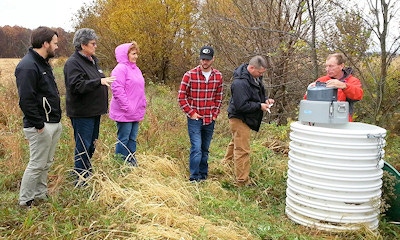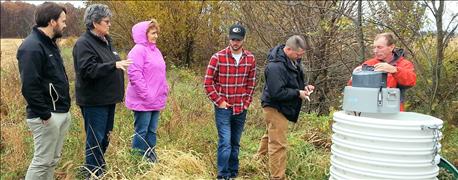February 29, 2016

One of this year’s Indiana Showcase Conservation Districts wasn’t a district at all - it was three of them! The Wabash, Miami, and Kosciusko SWCDs were honored for their work partnering with Manchester University and others to create what became the Middle Eel River Watershed Initiative.
MERWI was created to address environmental problems of a 30-mile stretch of the Eel River, extending from Mexico to North Manchester, and including tributaries from Kosciusko County. The Eel had been listed on the 2008 Indiana Impaired Waters List, due to excess silt and other contaminants.
Related: Wabash County's 'Poor Farm' sprouts new purposes for conservation

CHECK PROGRESS; Indiana Conservation Partnership leaders checked out a water monitoring device. They include, left to right, Patrick Glassman, NRCS; Jane Hardisty, NRCS state conservationist; Darci Zolman of Kosciusko SWCD, Collin Huffine, Manchester University; Rick Duff, NRCS and Jerry Sweeten, Manchester Univeristy. (Photo courtesy Wabash SWCD)
According to Susi Stephan, executive director of the Wabash SWCD, it began in 2007. Jerry Sweeten, director of environmental studies at Manchester University, approached then-Wabash NRCS district conservationist Joe Updike about partnering to apply for an EPA Section 319 grant. He wondered if increased adoption of conservation practices could improve water quality.
Updike enlisted help from district conservationists Rick Duff, Miami County, and Sam Sinclair, Kosciusko County. In December 2008 the group was awarded $1 million, with $212,000 of it earmarked for cost-share. A watershed management plan was written and a coordinator was hired.
Once started, “everything just snowballed,” says Stephan. The initial core group was joined by the Indiana Department of Natural Resources, ISDA, the Environmental Defense Fund and many other partner/stakeholders. Additional funding was received from the Indiana Soybean Alliance and Indiana Corn Marketing Council.
MERWI consists of four major components:
• Implement the Watershed Management Plan
• Administer a rigorous water quality monitoring plan. This component is conducted by Manchester University, using equipment and student interns.
• Implement a cost-share program to encourage adoption of conservation practices, carried out by the three conservation districts.
• Educate the public- some primary events include annual public meetings, river cleanups and canoe floats. More than 500 people participated in the floats, where people learn ways to positively impact the river, including by using cover crops.
A second grant was received for 2013 to 2015 for $833,000, with $250,000 allocated to cost share. Stephan says one original goal of the Initiative was to “turn specific sections of the watershed green,” with farmers adopting no-till, cover crops and nutrient management. She says they haven’t got there yet, but that it’s much “greener” than when they started.
Related: Indiana farmer shares why he believes in conservation, cover crops
“It’s hard for farmers to change their management practices, but we’ve had some who walked in as a result of the canoe float, and signed up for cover crops,” she says. “We consider that a success.”
The water monitoring component will take several years to assess the amount of change resulting from increasing adoption of conservation best management practices.
- Boone writes from Wabash
You May Also Like




